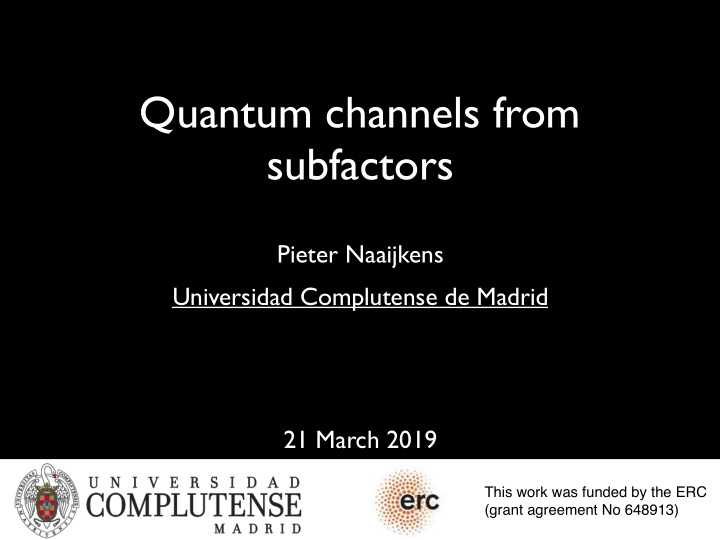



Quantum channels from subfactors Pieter Naaijkens Universidad Complutense de Madrid 21 March 2019 This work was funded by the ERC (grant agreement No 648913)
Three cultures Type I n : everything finite dimensional (no infinite resources) Type I ∞ : separable Hilbert space (e.g. quantum particle on line) Type III: focus on algebra of observables (particularly useful with infinite # d.o.f.) Thanks to Reinhard Werner for this characterisation.
Quantum information use quantum systems to communicate main question: how much information can I transmit? will consider infinite systems here… … described by subfactors channel capacity is given by Jones index
Outline Classical information theory Subfactors and QI
Classical information theory
Information theory Alice wants to communicate with Bob using a noisy channel . How much information can Alice send to Bob per use of the channel? Image source: Alfred Eisenstaedt/The LIFE Picture Collection
Setup Alice Bob output space input space How well can Bob recover the messages sent by Alice (small error allowed)?
Shannon entropy Def: Measure for the information content of X Coding: represent tuples in X n by codewords (asymptotically, error goes to zero!)
Relative entropy Compare two probability distributions P, Q : Vanishes iff P=Q , otherwise positive
Mutual information `information’ due to noise here the conditional entropy is defined: some algebra gives:
Channel capacities What is the maximum amount of information we can send through the channel? Def: the Shannon capacity of the channel is defined as:
Operational approach encode decode n channels N messages Maximum error for all possible encodings:
Coding theorem Def: R is called an achievable rate if The supremum of all R is called the capacity C .
Quantum information
Quantum information work mainly in the Heisenberg picture observables modelled by von Neumann algebra consider normal states on channels are normal unital CP maps Araki relative entropy
Araki relative entropy Let be faithful normal states: Def: Def:
Distinguishing states Alice prepares a mixed state : …and sends it to Bob Can Bob recover ?
Holevo 𝜓 quantity In general not exactly: Generalisation of Shannon information
Infinite systems Suppose is an infinite factor, say Type III, and a faithful normal state Better to compare algebras!
Comparing algebras Want to compare and , with subfactor Shirokov & Holevo, arXiv:1608.02203
A quantum channel For finite index inclusion , say irreducible, quantum channel, describes the restriction of operations
Jones index and entropy Hiai, J. Operator Theory, ’90; J. Math. Soc. Japan, ‘91 gives an information-theoretic interpretation to the Jones index
Quantum wiretapping Alice Bob Eve
Theorem (Devetak, Cai/Winter/Young) The rate of a wiretapping channel is given by 1 χ ( { p x } , Φ ⊗ n B ( ρ x ) } ) − χ ( { p x } , Φ ⊗ n � � lim n max E ( ρ x ) } ) n →∞ { p x , ρ x }
A conjecture The Jones index of a subfactor gives the [ M : N ] classical capacity of the wiretapping channel that restricts from to . M N L. Fiedler, PN, T.J. Osborne, New J. Phys 19 :023039 (2017) PN, Contemp. Math. 717 , pp. 257-279 (2018), arXiv:1704.05562
Some remarks use entropy formula by Hiai together with properties of the index averaging drops out: single letter formula coding theorem is missing
Recommend
More recommend